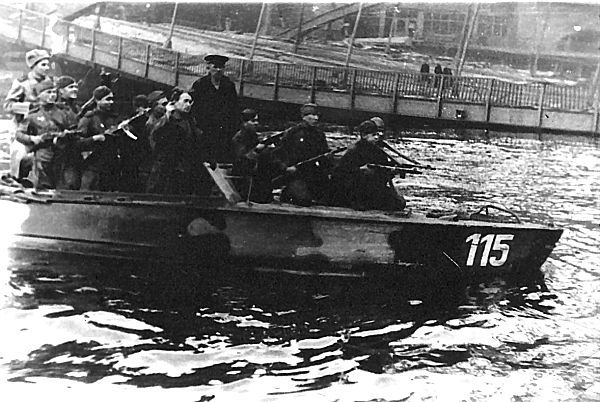







The 9th Rifle Corps as part of the 5th Shock Army was fighting its way thru the eastern suburbs finally reaching the Spree on April 22.
With all bridges destroyed and well entranched enemy on the western shore. the river Spree was about to become a main obstacle on the way to the Reichstag.
Fortunately, Berzarin had at his dispoval all three brigades of the Dniepr Flotilla consisting of a wide range of river boats :
- 24 bronekater
- 6 gunboats
- 16 patrol boats
- 9 floating batteries
- 20 trawlers boats
- 3 mortar boats
- 10 PVO AA defense boats and
- 30 Poluglisser.
Made completely out of plywood with a 1.2-ton weight and driven by the 50hp engine of the GAZ-M1 "Emka" staff car, as fast as 40 km/h und with a shallow draft of no more than 55 cm, the Poluglissers were extremely manouverable, reliable and still capable of transporting 15 men.
The second crew member operated the Maxim machinegun and was able to replace the commander in combat.
However the boats were completely unarmoured and thus vulnerable to even the lightest gunfire.
Originally scheduled for reconaissance and communication tasks only, the poluglissers proved their combat value on several occasions, e.g. on
- the Berezina
- the Pripyat at Pinsk
- the Western Bug at Serock and
- the Vistula around Warsaw.


From the start, an angry enemy tried to prevent any crossing by spreading all kinds of bullets over the sailors.
However, from April 23-25 the poluglissers managed to move no less than 16.000 soldiers and 27 tanks on pontoons to the other side, albeit at very high costs.
Several boats were damaged by panzerfaust ("faustpatron") and all but 2 commanders killed in action.
9 out of ten commanders were awarded "Hero of the Soviet Union", the remaining one left out probably due to his jewish (!) origine.














No publication in any form without the author's written permission.
Last Updated: February 28, 2016